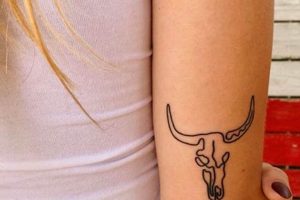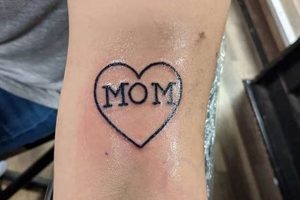Minimalist and easily executed designs, suitable for initial tattoo experiences, often involve clean lines, small symbols, and limited color palettes. Examples include single words, outlines of animals or objects, geometric patterns, and small floral elements. These designs generally heal quickly and require less complex aftercare.
Choosing an uncomplicated design for a first tattoo offers numerous advantages. Smaller tattoos tend to be more affordable and allow individuals to assess their pain tolerance before committing to larger, more intricate pieces. The relative simplicity also allows for greater flexibility in placement on the body. Historically, the practice of tattooing has evolved from complex tribal markings to encompass a wide range of aesthetic choices, with minimalist designs becoming increasingly popular in modern times. This trend reflects a desire for personalized yet understated body art.
The following sections will explore various design categories suitable for initial tattoos, offer guidance on selecting appropriate placement, and discuss crucial aftercare procedures.
Tips for Choosing a First Tattoo
Careful consideration should be given to the selection of a first tattoo design. The following tips offer guidance for navigating this process.
Tip 1: Research Thoroughly: Explore various design styles and artists’ portfolios. Gathering inspiration from multiple sources allows for informed decision-making.
Tip 2: Consider Placement: Tattoo visibility and pain levels vary depending on body location. Research placement options and their implications.
Tip 3: Size Matters: Smaller designs are often recommended for first tattoos due to lower cost, healing time, and pain tolerance assessment.
Tip 4: Simplicity is Key: Intricate details can be challenging for novice tattoo artists. Opting for clean lines and minimal shading often yields better results.
Tip 5: Color Considerations: Black ink tends to age better and requires less touch-up than colored inks. Limiting the color palette can simplify the process.
Tip 6: Consult a Professional: Experienced tattoo artists offer valuable insights and can help refine design choices based on individual preferences and skin type.
Tip 7: Reflect on Meaning: A tattoo is a permanent commitment. Choosing a design with personal significance ensures long-term satisfaction.
By following these guidelines, individuals can increase the likelihood of a positive first tattoo experience and a design they will cherish for years to come.
These considerations pave the way for a successful and meaningful first tattoo experience. The subsequent section will offer further details on aftercare and maintenance.
1. Small Symbols
Small symbols represent a cornerstone of simple first tattoo designs. Their inherent minimalism aligns seamlessly with the desire for an uncomplicated, easily managed initial tattoo experience. The reduced scale minimizes both the commitment and the potential for discomfort during the procedure. Moreover, smaller designs generally heal more quickly and present fewer complications during the aftercare process. Examples of popular small symbols include geometric shapes, minimalist representations of animals or flowers, single letters, and astrological signs. These symbols often carry profound personal meaning condensed into a compact, aesthetically pleasing form. A small wave, for instance, can symbolize a love for the ocean, while a semicolon can represent resilience and overcoming struggles. The inherent versatility of small symbols allows for discreet placement on various body parts, further contributing to their popularity as first tattoos.
The practical implications of choosing a small symbol for a first tattoo are significant. Beyond the aforementioned benefits regarding healing and pain management, these designs offer greater flexibility for future additions or modifications. Should an individual decide to expand their tattoo collection, a small symbol can easily be incorporated into a larger, more complex piece. Furthermore, the relatively low cost associated with smaller tattoos reduces the financial barrier to entry for those exploring body art for the first time. This allows individuals to gain experience and assess their personal preferences before committing to more extensive and expensive designs.
In summary, the popularity of small symbols as first tattoos stems from a combination of practical considerations and aesthetic appeal. Their compact size, simplified design, and symbolic potential offer a compelling entry point into the world of body art. Careful consideration of symbol choice and placement can result in a meaningful and aesthetically pleasing first tattoo experience, laying the foundation for future artistic exploration on the body canvas.
2. Minimalist Lines
Minimalist linework plays a crucial role in the realm of simple first tattoo designs. The clean, uncluttered aesthetic achieved through this approach aligns perfectly with the desire for an understated yet impactful initial tattoo. This style emphasizes precision and clarity, utilizing fine lines to create impactful designs without overwhelming the viewer or the wearer. The following facets further explore the significance of minimalist lines in simple first tattoo design.
- Emphasis on Simplicity:
Minimalist line tattoos prioritize essential elements, stripping away unnecessary details. This focus on simplicity results in designs that are both visually appealing and manageable for first-time tattoo recipients. Examples include single-line drawings of objects, animals, or geometric patterns. This approach reduces complexity, making the tattooing process smoother and potentially less painful. The streamlined nature of these designs also promotes faster healing.
- Versatility and Adaptability:
The adaptable nature of minimalist lines allows for seamless integration with various tattoo styles and placements. Whether on the wrist, ankle, or behind the ear, minimalist linework can be tailored to fit the contours of the body. Examples include delicate floral outlines, minimalist script, or abstract patterns. This adaptability makes minimalist lines an ideal choice for individuals seeking a subtle yet expressive first tattoo.
- Timeless Elegance:
Minimalist line tattoos possess a timeless quality, ensuring the design remains aesthetically pleasing for years to come. The clean, understated nature of these tattoos avoids trends that may quickly become dated. Examples include geometric shapes, celestial motifs, or simple line portraits. This enduring appeal makes minimalist lines a prudent choice for a first tattoo, minimizing the risk of future regret.
- Ease of Execution and Aftercare:
From an artist’s perspective, minimalist linework is often easier to execute precisely, leading to cleaner results. The simplified design also translates to easier aftercare for the recipient. Fewer lines mean less surface area to heal, reducing the risk of complications. This straightforward approach makes minimalist lines an excellent starting point for individuals embarking on their tattoo journey.
The convergence of these facets underscores the significance of minimalist lines within the context of simple first tattoo ideas. By prioritizing clean aesthetics, adaptability, and ease of execution, minimalist linework empowers individuals to embark on their tattoo journey with confidence, ensuring a positive and aesthetically fulfilling experience.
3. Limited Color Palette
A limited color palette is a defining characteristic of simple first tattoo designs. Restricting the number of inks used, often to black ink only, contributes significantly to a less complex and more manageable initial tattoo experience. This choice offers several advantages, impacting both the artistic process and the healing journey. Simpler designs using black ink allow novice tattoo artists to focus on linework and shading precision without the added complexity of color blending and transitions. This focus often results in a cleaner, sharper final product. Furthermore, a limited palette simplifies the healing process. Fewer inks introduced into the skin translate to a reduced risk of allergic reactions and complications. Black ink, known for its stability and longevity, is less prone to fading over time compared to some brighter colors, requiring fewer touch-ups in the long run. A small, black ink outline of a meaningful symbol, for instance, embodies this principle, prioritizing clean aesthetics and uncomplicated healing.
The practical implications of a limited color palette extend beyond the initial tattooing and healing phases. Cost-effectiveness is a significant factor. Fewer inks mean lower material costs, making simpler designs more accessible, especially for first-time recipients. This allows individuals to explore the world of tattoos without a substantial financial commitment. Moreover, the timeless quality of black ink tattoos ensures the design remains aesthetically relevant over time, less susceptible to the fleeting nature of color trends. This permanence aligns with the inherent permanence of tattoos, making a limited color palette a prudent choice for a design intended to last a lifetime. From simple linework to intricate shading, black ink offers a versatile medium for artistic expression, capable of capturing intricate details and subtle nuances.
In conclusion, the emphasis on a limited color palette within the context of simple first tattoo ideas stems from a convergence of practical and aesthetic considerations. By streamlining the artistic process, promoting efficient healing, and ensuring long-term visual appeal, a limited color palette, often black ink alone, offers a sensible and impactful approach to initial tattoo design. This approach empowers individuals to embark on their tattoo journey with confidence, focusing on the essential elements of design and meaning while minimizing potential complications and maximizing long-term satisfaction. The inherent simplicity of a limited color palette lays a solid foundation for future artistic exploration in the realm of body art, should the individual choose to expand their tattoo collection in the future.
4. Meaningful Concepts
Meaningful concepts form the bedrock of successful simple first tattoo designs. While aesthetic appeal holds importance, a design resonating with personal significance ensures long-term satisfaction. This intrinsic connection between personal meaning and design choice elevates a simple tattoo from mere adornment to a powerful symbol of individual identity, values, or experiences. A seemingly simple design can hold profound meaning for the wearer, representing a loved one, a significant life event, a personal belief, or a cherished memory. A small, unassuming wave, for instance, could represent a connection to the ocean, a passion for surfing, or a tribute to a coastal upbringing. Similarly, a single word in a minimalist font might encapsulate a core value, a life motto, or a reminder of a significant personal journey. This emphasis on meaning imbues the tattoo with emotional depth, strengthening the individual’s connection to the chosen design.
The process of selecting a meaningful concept often involves introspection and careful consideration. Individuals are encouraged to explore themes, symbols, and motifs that resonate deeply with their personal narratives. Researching symbolism across cultures and historical periods can further enrich this process, unveiling a wealth of potential meanings associated with various imagery. Consulting with experienced tattoo artists can also provide valuable insights and guidance, helping individuals translate abstract concepts into visually compelling and personally relevant designs. This collaborative approach ensures the final design accurately reflects the intended meaning, maximizing its personal significance for the wearer. Choosing a design rooted in personal meaning enhances the tattoo’s value beyond its aesthetic qualities, transforming it into a tangible representation of the individual’s identity and story.
In conclusion, the interplay between meaningful concepts and simple first tattoo ideas is crucial. A tattoo imbued with personal significance transcends mere aesthetics, becoming a powerful symbol of individual identity and lived experience. This understanding underscores the importance of thoughtful design selection, emphasizing the value of introspection and research in the process. By prioritizing meaningful concepts, individuals embarking on their tattoo journey ensure a result that resonates deeply and endures over time, enriching their connection to their chosen body art. The subsequent exploration of placement will further enhance the understanding of how these meaningful designs integrate harmoniously with the individual’s physical form.
5. Strategic Placement
Strategic placement is integral to simple first tattoo designs, maximizing aesthetic impact while accommodating practical considerations. Placement influences visibility, pain levels, and how the design interacts with the body’s contours. A small wrist tattoo, for example, allows for easy display or concealment depending on attire. Conversely, a ribcage tattoo offers a more private canvas, experiencing greater sensitivity due to thinner skin and proximity to bone. Placement should also consider professional contexts; a visible neck tattoo, while aesthetically striking, might not be suitable for all work environments. Careful consideration of placement ensures the tattoo harmonizes with lifestyle and personal preferences. This thoughtful approach allows individuals to curate a body art experience aligned with their individual needs and circumstances.
Practical implications of strategic placement extend beyond initial considerations. Areas subject to frequent friction, such as the inner wrist or ankle, may experience faster ink fading. Sun exposure also impacts longevity; tattoos in consistently exposed areas require diligent sun protection to maintain vibrancy. Furthermore, the body’s natural aging process affects skin elasticity, potentially distorting tattoos over time. Placement on areas less prone to stretching, like the outer forearm or shoulder blade, minimizes this risk. Understanding these factors informs placement decisions, maximizing the tattoo’s long-term aesthetic appeal. Consulting with experienced tattoo artists provides valuable insights regarding placement, leveraging their anatomical knowledge and artistic expertise to optimize design longevity and visual impact.
In summary, strategic placement optimizes the interplay between design and body canvas within the context of simple first tattoo ideas. Considering factors like visibility, pain tolerance, professional appropriateness, and the body’s natural aging process ensures the chosen design integrates seamlessly and endures aesthetically. This careful approach enhances both the immediate and long-term satisfaction derived from a first tattoo, fostering a positive and enduring relationship with body art.
Frequently Asked Questions
Addressing common inquiries regarding initial tattoo experiences clarifies potential concerns and facilitates informed decision-making.
Question 1: How much do simpler, smaller tattoos typically cost?
Pricing varies depending on artist, studio location, and design intricacy. However, smaller, simpler designs generally incur lower costs compared to larger, more complex pieces. Consulting with chosen artists directly provides accurate pricing information.
Question 2: What body locations are generally considered less painful for a first tattoo?
Outer thighs, outer arms, shoulders, and calves tend to be less sensitive. Areas with thinner skin or closer proximity to bone, like ribs, ankles, or wrists, may experience heightened sensitivity.
Question 3: How long does the healing process typically take for a simple tattoo?
Healing time typically ranges from two to four weeks, depending on individual factors and tattoo size. Adhering to aftercare instructions provided by the tattoo artist is crucial for optimal healing.
Question 4: Can one donate blood after getting a tattoo?
Most blood donation centers require a waiting period after receiving a tattoo, typically ranging from four months to a year, to minimize potential infection risks. Contacting local blood donation centers clarifies specific guidelines.
Question 5: What factors should be considered when choosing a tattoo artist?
Researching artists’ portfolios, verifying licensing and hygiene practices, and seeking recommendations contribute to informed selections. A consultation with potential artists allows for discussion of design ideas and assessment of artistic compatibility.
Question 6: How does one ensure a tattoo ages well?
Protecting tattoos from excessive sun exposure with sunscreen and maintaining healthy skin hydration practices minimizes fading and preserves vibrancy over time. Following recommended aftercare procedures immediately after receiving the tattoo sets the foundation for long-term aesthetic preservation.
Thorough consideration of these frequently asked questions equips individuals with essential knowledge for navigating their initial tattoo experience successfully.
Further exploration of specific design ideas provides additional inspiration for potential first tattoos.
Simple First Tattoo Ideas
Careful consideration of design elementssize, symbolism, linework, color palette, and placementis paramount when selecting an initial tattoo. Prioritizing simpler designs offers numerous advantages, including reduced pain, faster healing, lower costs, and greater adaptability for future additions. Meaningful concepts embedded within minimalist aesthetics transform body art into powerful personal statements, reflecting individual narratives and values. Strategic placement further enhances this connection, harmonizing design with the body’s natural contours while accommodating practical considerations like visibility and professional contexts. Thorough research, consultation with experienced artists, and diligent aftercare ensure successful execution and long-term satisfaction.
A well-chosen first tattoo serves as a stepping stone into the rich world of body art, offering a tangible expression of self and paving the way for future artistic exploration. The permanence of this decision underscores the importance of thoughtful consideration and informed choices, ensuring a positive and enduring relationship with this powerful form of self-expression.







